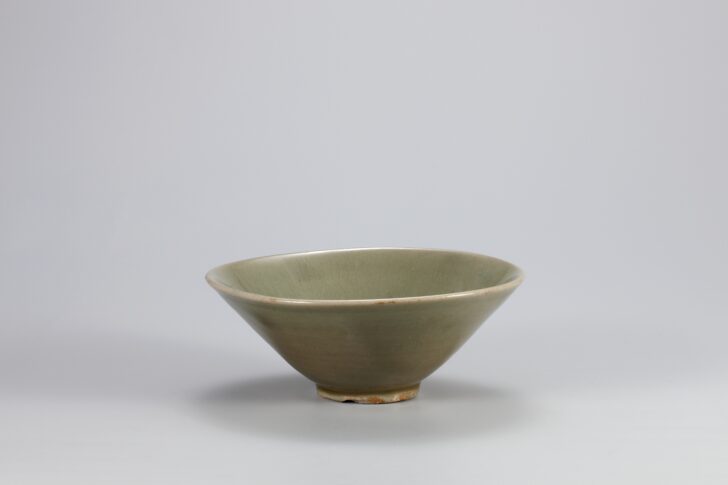Tea Bowl
Korean

Description
The appeal of this undecorated bowl lies in the soft blue-green tone of the slightly crackled glaze. Celadon bowls of this color were considered perfect for drinking red brick tea, the tea that was in favor in China and Korea at the time.
----
Korean celadons are considered one of the great artistic achievements of the world. These four bowls date from the early period of true Korean celadon production, from the eleventh century to the early twelfth century, when Goryeo potters no longer slavishly copied Chinese celadon wares as they did from the ninth through the tenth century. Through the process of Koreanization, this vessel type became more delicate in shape, narrower in foot-rim, and thinner in the vessel wall and glazing.
The much-prized color results from the combination of a gray clay body containing small amounts of iron with a glaze of about two to three percent iron. This combination of iron turns green when fired in a reduction (deoxidizing) atmosphere at a temperature of 1150–1250 degrees Celsius; the firing occurs over several days in a wood-fueled climbing kiln built into the slope of a mountain. The green of the glaze varies according to the properties of the clay body, glaze, and kiln conditions. As seen in these four bowls, a wide range of celadon greens is possible: tinged with yellow, brown, gray, or blue, in light to dark shades.
Early Goryeo celadon bowls were undecorated or simply adorned with discreetly incised and/or carved decoration, especially on their interiors. Decorative motifs of single lines; large floral sprays of lotus, peony, or chrysanthemum; fish and wave; and paired parrots predominate on these early wares. The confident, freehand drawing was executed with a pointed wooden carving tool onto the leather-hard clay body before glazing. For the subtle designs to show clearly, the glaze application had to be thin and uniform, as seen on two of the bowls in this group.
These elegant bowls were likely used by nobles or monks for serving food and drinking tea. The more conical bowls, called wan by Koreans, were particularly suited for tea. The soft blue–green glaze was considered perfect for showing off the color of red brick tea, which was favored at that time in China and Korea. Chunks of powdered tea were broken off the brick and whisked into a frothy brew with hot water poured directly into the bowls. The wide mouths and shallow bodies of wan facilitated the preparation and consumption of tea in the same elegant bowl.
(Label for UMMA Korean Gallery Opening Rotation, March 2009)
Subject Matter:
Celadon Tea Bowl
Physical Description:
This bowl exemplifies early-tenth century celadon forms influenced by Chinese Yue ware. It has a halo-shaped foot (haemurigup), a characteristic of Yue ware. It is a high-quality celadon made from fine clay, coated by highly transparent glaze. Surface is plain while displaying crackles on its inner surface and parts of its outer surface. Many similar vessels were excavated from the Kilns no. 9 and no. 10 at Yongun-ri, Gangjin-gun, Jeollanam-do. Refractory spur marks created during firing remain in five places on the rim of the foot.
[Korean Collection, University of Michigan Museum of Art (2014) p.88]
Usage Rights:
If you are interested in using an image for a publication, please visit https://umma.umich.edu/request-image/ for more information and to fill out the online Image Rights and Reproductions Request Form.